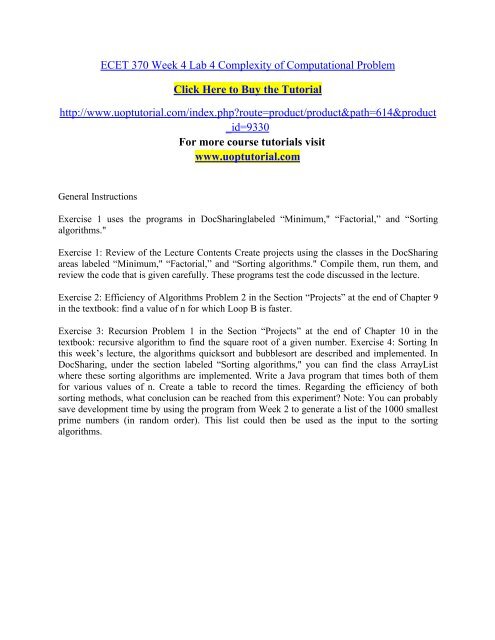ECET 370 Week 4 Lab 4 Complexity of Computational Problems (2)
General Instructions Exercise 1 uses the programs in DocSharinglabeled “Minimum," “Factorial,” and “Sorting algorithms." Exercise 1: Review of the Lecture Contents Create projects using the classes in the DocSharing areas labeled “Minimum," “Factorial,” and “Sorting algorithms." Compile them, run them, and review the code that is given carefully. These programs test the code discussed in the lecture. Exercise 2: Efficiency of Algorithms Problem 2 in the Section “Projects” at the end of Chapter 9 in the textbook: find a value of n for which Loop B is faster. Exercise 3: Recursion Problem 1 in the Section “Projects” at the end of Chapter 10 in the textbook: recursive algorithm to find the square root of a given number. Exercise 4: Sorting In this week’s lecture, the algorithms quicksort and bubblesort are described and implemented. In DocSharing, under the section labeled “Sorting algorithms," you can find the class ArrayList where these sorting algorithms are implemented. Write a Java program that times both of them for various values of n. Create a table to record the times. Regarding the efficiency of both sorting methods, what conclusion can be reached from this experiment? Note: You can probably save development time by using the program from Week 2 to generate a list of the 1000 smallest prime numbers (in random order). This list could then be used as the input to the sorting algorithms.
General Instructions
Exercise 1 uses the programs in DocSharinglabeled “Minimum," “Factorial,” and “Sorting algorithms."
Exercise 1: Review of the Lecture Contents Create projects using the classes in the DocSharing areas labeled “Minimum," “Factorial,” and “Sorting algorithms." Compile them, run them, and review the code that is given carefully. These programs test the code discussed in the lecture.
Exercise 2: Efficiency of Algorithms Problem 2 in the Section “Projects” at the end of Chapter 9 in the textbook: find a value of n for which Loop B is faster.
Exercise 3: Recursion Problem 1 in the Section “Projects” at the end of Chapter 10 in the textbook: recursive algorithm to find the square root of a given number. Exercise 4: Sorting In this week’s lecture, the algorithms quicksort and bubblesort are described and implemented. In DocSharing, under the section labeled “Sorting algorithms," you can find the class ArrayList where these sorting algorithms are implemented. Write a Java program that times both of them for various values of n. Create a table to record the times. Regarding the efficiency of both sorting methods, what conclusion can be reached from this experiment? Note: You can probably save development time by using the program from Week 2 to generate a list of the 1000 smallest prime numbers (in random order). This list could then be used as the input to the sorting algorithms.
- No tags were found...
You also want an ePaper? Increase the reach of your titles
YUMPU automatically turns print PDFs into web optimized ePapers that Google loves.
<strong>ECET</strong> <strong>370</strong> <strong>Week</strong> 4 <strong>Lab</strong> 4 <strong>Complexity</strong> <strong>of</strong> <strong>Computational</strong> Problem<br />
Click Here to Buy the Tutorial<br />
http://www.uoptutorial.com/index.php?route=product/product&path=614&product<br />
_id=9330<br />
For more course tutorials visit<br />
www.uoptutorial.com<br />
General Instructions<br />
Exercise 1 uses the programs in DocSharinglabeled “Minimum," “Factorial,” and “Sorting<br />
algorithms."<br />
Exercise 1: Review <strong>of</strong> the Lecture Contents Create projects using the classes in the DocSharing<br />
areas labeled “Minimum," “Factorial,” and “Sorting algorithms." Compile them, run them, and<br />
review the code that is given carefully. These programs test the code discussed in the lecture.<br />
Exercise 2: Efficiency <strong>of</strong> Algorithms Problem 2 in the Section “Projects” at the end <strong>of</strong> Chapter 9<br />
in the textbook: find a value <strong>of</strong> n for which Loop B is faster.<br />
Exercise 3: Recursion Problem 1 in the Section “Projects” at the end <strong>of</strong> Chapter 10 in the<br />
textbook: recursive algorithm to find the square root <strong>of</strong> a given number. Exercise 4: Sorting In<br />
this week’s lecture, the algorithms quicksort and bubblesort are described and implemented. In<br />
DocSharing, under the section labeled “Sorting algorithms," you can find the class ArrayList<br />
where these sorting algorithms are implemented. Write a Java program that times both <strong>of</strong> them<br />
for various values <strong>of</strong> n. Create a table to record the times. Regarding the efficiency <strong>of</strong> both<br />
sorting methods, what conclusion can be reached from this experiment? Note: You can probably<br />
save development time by using the program from <strong>Week</strong> 2 to generate a list <strong>of</strong> the 1000 smallest<br />
prime numbers (in random order). This list could then be used as the input to the sorting<br />
algorithms.













